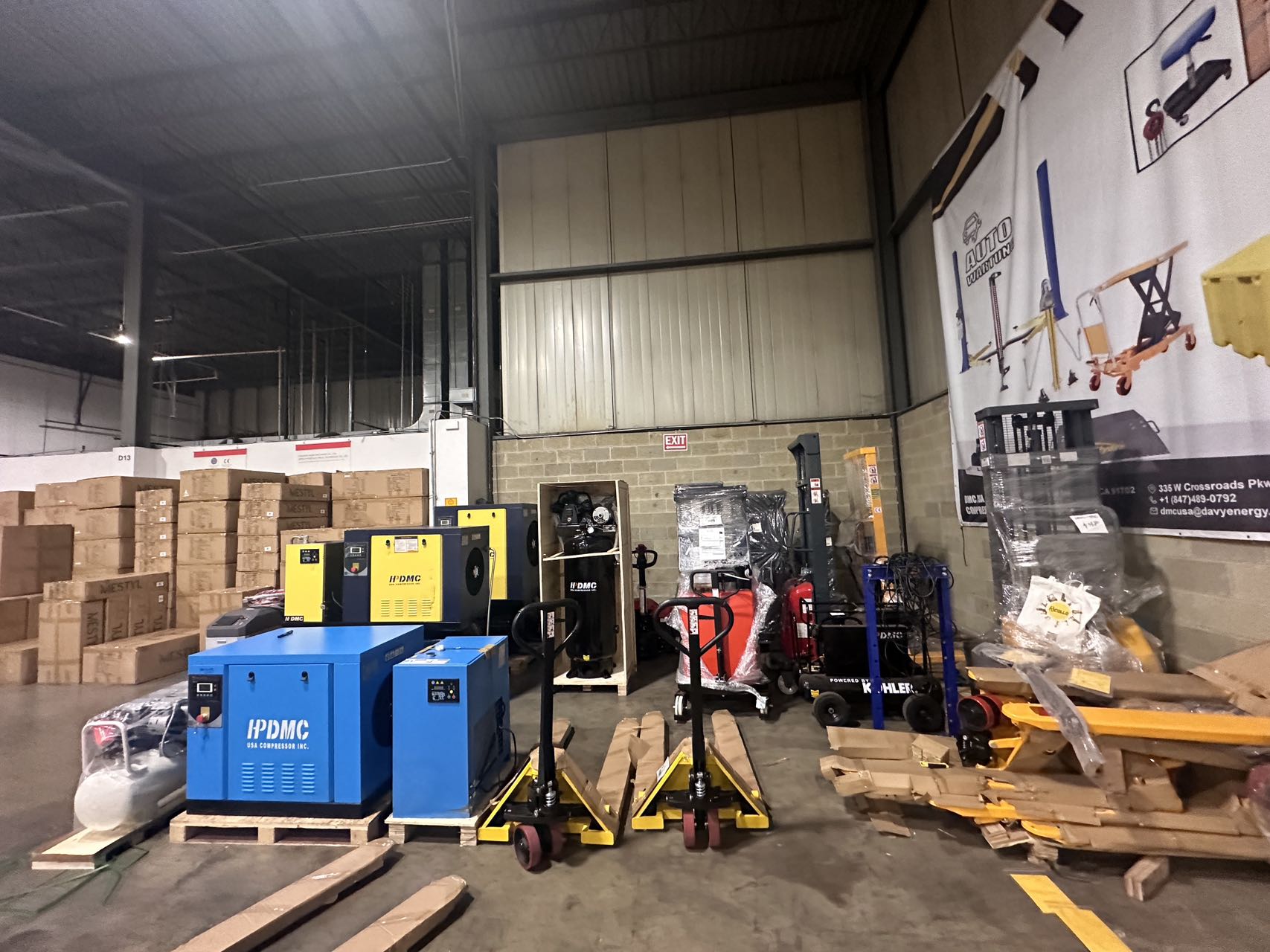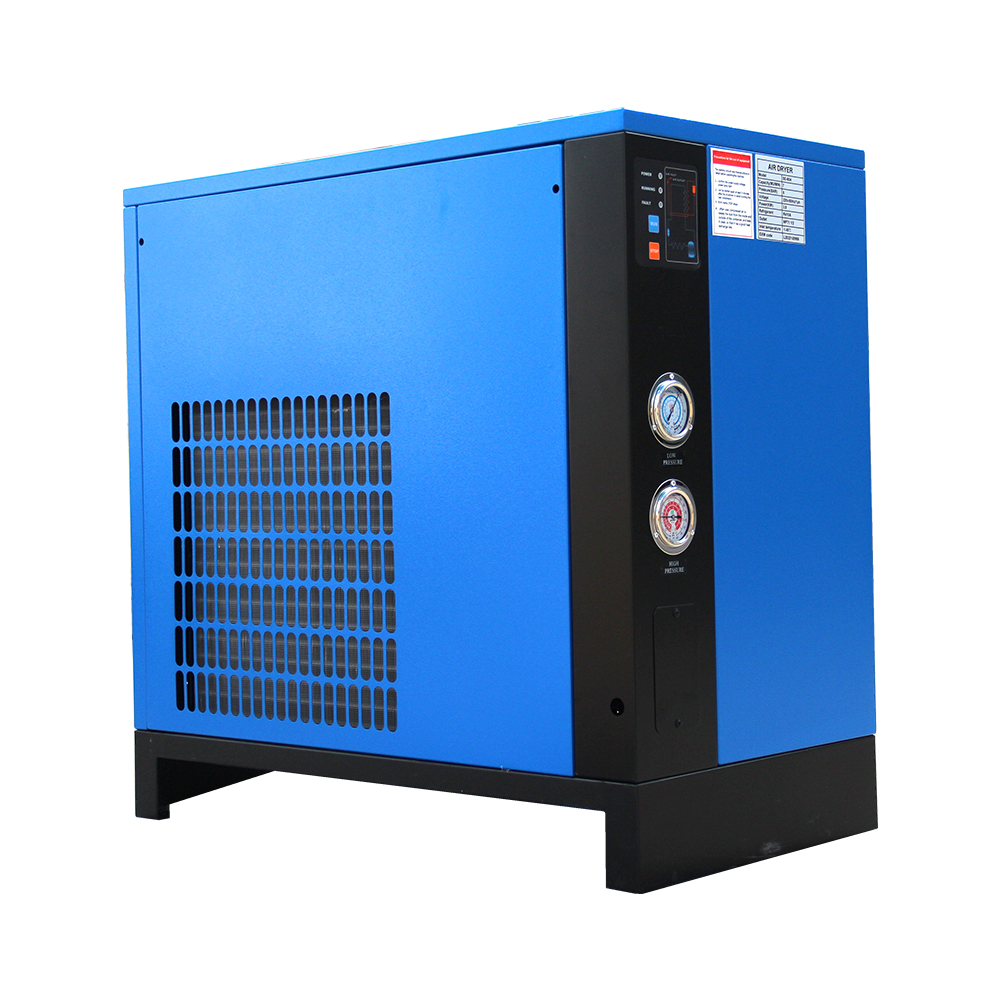
Introduction
Refrigerated air dryers play a crucial role in compressed air systems by removing moisture and contaminants. This is essential because moisture in compressed air can cause various problems, including equipment corrosion, clogging of pneumatic tools, and degradation of product quality in certain applications. Understanding the applications and key considerations for selecting a refrigerated air dryer is vital for maintaining the efficiency and reliability of compressed air systems.
Working Principle and Applications
Working Principle
Refrigerated air dryers operate by cooling compressed air to remove moisture. The compressed air passes through a heat exchanger, where it is cooled to a temperature near the dew point. As the air cools, the moisture condenses into liquid form, which is then separated and drained from the system.
Once the moisture is removed, the dried air is reheated to approximately room temperature before being delivered for use. This reheating process helps prevent condensation in downstream piping and equipment. The cooling process is typically achieved using a refrigerant, such as the environmentally friendly Refrigerant 134a used in the HPDMC model, which circulates through a refrigeration cycle to absorb heat from the compressed air.
Applications
Industrial Manufacturing
In manufacturing, clean and dry compressed air is essential for pneumatic tools, automated machinery, and production equipment.
For example:
● In automotive manufacturing, pneumatic tools are used for assembling components and painting. Moisture in compressed air can cause rust on metal parts or affect paint quality.
● A refrigerated air dryer ensures that the air remains dry and free from contaminants, improving the performance and lifespan of tools and equipment while enhancing overall production quality.
Food and Beverage Industry
The food and beverage industry has strict air quality requirements. Refrigerated air dryers help provide dry air for processes such as packaging, bottling, and pneumatic conveying of food products.
● Moisture in compressed air can contaminate food or beverages, leading to spoilage or quality issues.
● In clean-in-place (CIP) systems, dry air is required to properly dry equipment after cleaning, preventing bacterial growth.
Pharmaceutical and Medical Applications
In pharmaceutical manufacturing and medical facilities, the quality of compressed air is critical.
● Refrigerated air dryers are used in tablet coating, sterile container filling, and medical equipment operation (e.g., ventilators and anesthesia machines).
● Any moisture or contaminants could compromise product sterility, effectiveness, or patient safety.
● Precise air quality control is essential in these critical applications.
Electronics Manufacturing
Electronics manufacturing requires a clean and dry environment, as moisture can damage sensitive components.
● Compressed air is used for circuit board cleaning, pneumatic tool operation, and cleanroom applications.
● Even minimal moisture can cause corrosion and product failure.
● Refrigerated air dryers protect components and maintain high product reliability.
General Industrial and Commercial Facilities
Refrigerated air dryers are widely used in industrial and commercial settings to improve pneumatic system performance and longevity.
● In workshops and garages, they prevent pneumatic tools from rusting and ensure smooth operation.
● In HVAC systems, dry air prevents clogging and malfunctions in actuators and controls, ensuring efficient system operation.
Key Considerations for Selection
Capacity and Pressure Requirements
The dryer’s capacity should match the airflow rate (CFM - Cubic Feet per Minute) of the compressed air system.
● An undersized dryer may fail to remove moisture effectively, leading to wet air downstream.
● An oversized dryer may be more expensive and less energy-efficient.
Additionally, the pressure rating should be compatible with the system’s operating pressure, considering both maximum and normal pressures for safe and effective performance.
Dew Point Temperature
The dew point temperature indicates when moisture will start to condense out of the air.
● Some industrial applications require lower dew points to prevent moisture-related issues, while others may tolerate slightly higher dew points.
● The HPDMC SE Series air dryer is designed to maintain a consistent dew point, ensuring reliable performance.
● Choosing a dryer that meets the specific dew point requirements of an application is crucial for effective moisture control.
Energy Efficiency
Energy consumption significantly affects the operating cost of an air dryer. Look for:
● Efficient compressors, heat exchangers, and control systems to optimize the refrigeration cycle.
● Zero-loss drains, which minimize compressed air loss during condensate removal.
● Energy-efficient designs can lead to long-term cost savings and reduce environmental impact.
Maintenance and Reliability
Regular maintenance is necessary to keep the dryer running efficiently. Consider:
● Ease of maintenance for tasks like filter replacement, refrigerant charging (if applicable), and component inspection.
● The HPDMC SE Series air dryer features a simple control system and a zero-loss condensate drain, requiring less maintenance than some other models.
● Selecting a reliable and durable dryer minimizes downtime and maintenance costs while ensuring continuous dry air supply.
Compatibility with Existing Systems
Ensure the air dryer integrates seamlessly with your compressed air system.
● Check connection sizes, voltage requirements, and control interfaces.
● It should be compatible with the compressor, air storage tanks, and other components.
● Some dryers offer adjustable pressure settings and system communication features for better integration.
Refrigerated Air Dryer with Microprocessor Control and Environmentally Friendly Refrigerant 134a
This high-performance Refrigerated Air Dryer with Microprocessor Control is designed for efficient moisture removal in compressed air systems.
Specifications:
● Capacity: 45 CFM
● Operating Pressure: 125 PSI
● Voltage Requirement: 110V/60Hz
● Dew Point: Maintains air at approximately +39°F, ensuring effective moisture removal.
Key Features:
● Two-stage heat exchanger system for consistent dew point maintenance.
● Zero-loss condensate drain removes condensed moisture efficiently while saving energy.
● Reheating process prevents pipe sweating and increases air volume after moisture removal.
Advanced Control System:
● Modulating refrigeration valves optimize performance, especially for constant loads.
● User-friendly indicators, including refrigerant system flow, run, and alarm lights.
● Analyzer gauge and lockable start/stop switch for safety and ease of control.
● Integrated moisture separator with five-step centrifugal separation for enhanced drying.
This system ensures that compressed air is clean and dry before reaching downstream equipment, enhancing performance and reliability in industrial applications.

